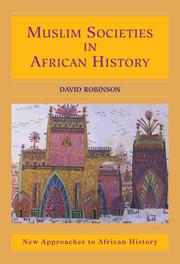Book contents
- Frontmatter
- Acknowledgments
- Contents
- LIST OF MAPS AND FIGURES
- INTRODUCTION
- PART I The Historical and Institutional Background
- PART II General Themes
- 3 The Islamization of Africa
- 4 The Africanization of Islam
- 5 Muslim Identity and the Slave Trades
- 6 Western Views of Africa and Islam
- PART III Case Studies
- CONCLUSION
- GLOSSARY
- INDEX
5 - Muslim Identity and the Slave Trades
Published online by Cambridge University Press: 05 June 2012
- Frontmatter
- Acknowledgments
- Contents
- LIST OF MAPS AND FIGURES
- INTRODUCTION
- PART I The Historical and Institutional Background
- PART II General Themes
- 3 The Islamization of Africa
- 4 The Africanization of Islam
- 5 Muslim Identity and the Slave Trades
- 6 Western Views of Africa and Islam
- PART III Case Studies
- CONCLUSION
- GLOSSARY
- INDEX
Summary
In the chapters on islamization and africanization I have not mentioned the slave trade and slavery. That was intentional, because I wanted to present Islam as a religious practice, which is what Arab founders and African practitioners intended. But islamization and africanization occurred in very specific contexts, political, economic, and social. Sometimes the context involved transforming people into commodities – what we commonly call enslavement, the slave trade, and slavery.
For most of human history, systems of exploitation called slavery have existed and have required practices of “recruitment” or slave trade to bring new men, women, and children into bondage. Definitions based on religious identity have usually been a part of enslavement. Africa has been no exception to the practice of slavery and the slave trade, either inside the continent or by export to other areas. In fact, although the name slave originates from Slav and the Roman Empire's exploitation of eastern Europe, no area of the world has been more victimized by slave trade and slavery than Sub-Saharan Africa. Slaves who were Muslim used their religious identity as comfort and a rallying cry in some of those systems. In others slave traders and slave owners used Islamic identity to justify enslavement. It is this resource of Islamic identity that I explore in this chapter.
- Type
- Chapter
- Information
- Muslim Societies in African History , pp. 60 - 73Publisher: Cambridge University PressPrint publication year: 2004

